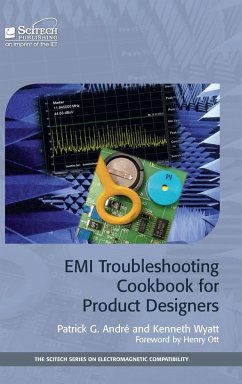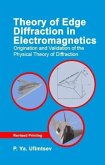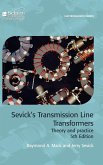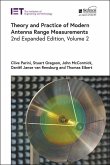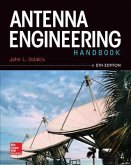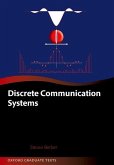- Gebundenes Buch
- Merkliste
- Auf die Merkliste
- Bewerten Bewerten
- Teilen
- Produkt teilen
- Produkterinnerung
- Produkterinnerung
EMI Troubleshooting Cookbook for Product Designers provides the 'recipe' for identifying why products fail to meet EMI/EMC regulatory standards.
Andere Kunden interessierten sich auch für
![EMC Pocket Guide: Key EMC Facts, Equations and Data EMC Pocket Guide: Key EMC Facts, Equations and Data]() Kenneth WyattEMC Pocket Guide: Key EMC Facts, Equations and Data33,99 €
Kenneth WyattEMC Pocket Guide: Key EMC Facts, Equations and Data33,99 €![Theory of Edge Diffraction in Electromagnetics: Origination and Validation of the Physical Theory of Diffraction Theory of Edge Diffraction in Electromagnetics: Origination and Validation of the Physical Theory of Diffraction]() P.Ya. UfimtsevTheory of Edge Diffraction in Electromagnetics: Origination and Validation of the Physical Theory of Diffraction122,99 €
P.Ya. UfimtsevTheory of Edge Diffraction in Electromagnetics: Origination and Validation of the Physical Theory of Diffraction122,99 €![Sevick's Transmission Line Transformers Sevick's Transmission Line Transformers]() Raymond A. Mack (USA National Oilwell Varco)Sevick's Transmission Line Transformers99,99 €
Raymond A. Mack (USA National Oilwell Varco)Sevick's Transmission Line Transformers99,99 €![Retro-Reflective Beamforming Technique for Microwave Power Transmission Retro-Reflective Beamforming Technique for Microwave Power Transmission]() Mingyu Lu (West Virginia University Institute of Technol ProfessorRetro-Reflective Beamforming Technique for Microwave Power Transmission150,99 €
Mingyu Lu (West Virginia University Institute of Technol ProfessorRetro-Reflective Beamforming Technique for Microwave Power Transmission150,99 €![Theory and Practice of Modern Antenna Range Measurements Theory and Practice of Modern Antenna Range Measurements]() Clive Parini (Queen Mary Universi Professor of Antenna EngineeringTheory and Practice of Modern Antenna Range Measurements196,99 €
Clive Parini (Queen Mary Universi Professor of Antenna EngineeringTheory and Practice of Modern Antenna Range Measurements196,99 €![Antenna Engineering Handbook Antenna Engineering Handbook]() John VolakisAntenna Engineering Handbook219,99 €
John VolakisAntenna Engineering Handbook219,99 €![Discrete Communication Systems Discrete Communication Systems]() Stevan Berber (Associate Professor, Department of Electrical, CompuDiscrete Communication Systems113,99 €
Stevan Berber (Associate Professor, Department of Electrical, CompuDiscrete Communication Systems113,99 €-
-
-
EMI Troubleshooting Cookbook for Product Designers provides the 'recipe' for identifying why products fail to meet EMI/EMC regulatory standards.
Hinweis: Dieser Artikel kann nur an eine deutsche Lieferadresse ausgeliefert werden.
Hinweis: Dieser Artikel kann nur an eine deutsche Lieferadresse ausgeliefert werden.
Produktdetails
- Produktdetails
- Electromagnetic Waves
- Verlag: SciTech Publishing Inc
- Seitenzahl: 256
- Erscheinungstermin: 18. Juli 2014
- Englisch
- Abmessung: 240mm x 161mm x 18mm
- Gewicht: 514g
- ISBN-13: 9781613530191
- ISBN-10: 1613530196
- Artikelnr.: 37684280
- Herstellerkennzeichnung
- Libri GmbH
- Europaallee 1
- 36244 Bad Hersfeld
- gpsr@libri.de
- Electromagnetic Waves
- Verlag: SciTech Publishing Inc
- Seitenzahl: 256
- Erscheinungstermin: 18. Juli 2014
- Englisch
- Abmessung: 240mm x 161mm x 18mm
- Gewicht: 514g
- ISBN-13: 9781613530191
- ISBN-10: 1613530196
- Artikelnr.: 37684280
- Herstellerkennzeichnung
- Libri GmbH
- Europaallee 1
- 36244 Bad Hersfeld
- gpsr@libri.de
Patrick G. André received his physics degree in 1982 from Seattle University, with postgraduate work in Electrical Engineering and Physics. He has worked in the Electromagnetic Compatibility (EMC) field for over 30 years and is an iNARTE Certified Engineer in both EMC (Electromagnetic Compatibility) and ESD (Electrostatic Discharge), he also holds a Master Design Certificate. Patrick has worked in the military and aerospace environment for his entire career, and worked with commercial electronics since 1995. He has successfully worked with, and given input to, branches of the military and NASA, as well as several of their subcontractors. He has a strong ability in the test, measurement, and troubleshooting of EMC.
Chapter 1: Electromagnetic Fundamentals
Chapter 2: Electromagnetic Interference and Compatibility
Chapter 3: Instrumentation
Chapter 4: Radiated Emissions
Chapter 5: Conducted Emissions
Chapter 6: Radiated Susceptibility
Chapter 7: Conducted Susceptibility
Chapter 8: Electrically Fast Transient (EFT)
Chapter 9: Electrostatic Discharge (ESD)
Chapter 10: Transient Suppression for Surge and Lightning Pulses
Chapter 11: Other Specific EMI Issues
Appendix A: Conversions, Handy Formulas, and Definitions
Appendix B: Analyzing Clock Oscillators, Digital Sources and Harmonics
Appendix C: Using Reactance Graphs
Appendix D: Recommended EMI Toolkit
Appendix E: Filter Design
Appendix F: Measuring Resonant Structures
Appendix G: EMC Standards and Regulations
Appendix H: EMC Symbols and Acronyms
Chapter 2: Electromagnetic Interference and Compatibility
Chapter 3: Instrumentation
Chapter 4: Radiated Emissions
Chapter 5: Conducted Emissions
Chapter 6: Radiated Susceptibility
Chapter 7: Conducted Susceptibility
Chapter 8: Electrically Fast Transient (EFT)
Chapter 9: Electrostatic Discharge (ESD)
Chapter 10: Transient Suppression for Surge and Lightning Pulses
Chapter 11: Other Specific EMI Issues
Appendix A: Conversions, Handy Formulas, and Definitions
Appendix B: Analyzing Clock Oscillators, Digital Sources and Harmonics
Appendix C: Using Reactance Graphs
Appendix D: Recommended EMI Toolkit
Appendix E: Filter Design
Appendix F: Measuring Resonant Structures
Appendix G: EMC Standards and Regulations
Appendix H: EMC Symbols and Acronyms
Chapter 1: Electromagnetic Fundamentals
Chapter 2: Electromagnetic Interference and Compatibility
Chapter 3: Instrumentation
Chapter 4: Radiated Emissions
Chapter 5: Conducted Emissions
Chapter 6: Radiated Susceptibility
Chapter 7: Conducted Susceptibility
Chapter 8: Electrically Fast Transient (EFT)
Chapter 9: Electrostatic Discharge (ESD)
Chapter 10: Transient Suppression for Surge and Lightning Pulses
Chapter 11: Other Specific EMI Issues
Appendix A: Conversions, Handy Formulas, and Definitions
Appendix B: Analyzing Clock Oscillators, Digital Sources and Harmonics
Appendix C: Using Reactance Graphs
Appendix D: Recommended EMI Toolkit
Appendix E: Filter Design
Appendix F: Measuring Resonant Structures
Appendix G: EMC Standards and Regulations
Appendix H: EMC Symbols and Acronyms
Chapter 2: Electromagnetic Interference and Compatibility
Chapter 3: Instrumentation
Chapter 4: Radiated Emissions
Chapter 5: Conducted Emissions
Chapter 6: Radiated Susceptibility
Chapter 7: Conducted Susceptibility
Chapter 8: Electrically Fast Transient (EFT)
Chapter 9: Electrostatic Discharge (ESD)
Chapter 10: Transient Suppression for Surge and Lightning Pulses
Chapter 11: Other Specific EMI Issues
Appendix A: Conversions, Handy Formulas, and Definitions
Appendix B: Analyzing Clock Oscillators, Digital Sources and Harmonics
Appendix C: Using Reactance Graphs
Appendix D: Recommended EMI Toolkit
Appendix E: Filter Design
Appendix F: Measuring Resonant Structures
Appendix G: EMC Standards and Regulations
Appendix H: EMC Symbols and Acronyms

